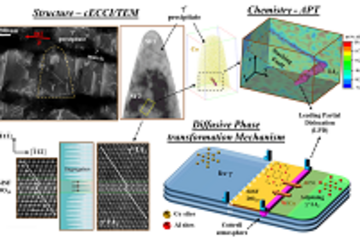All genres
21.
Journal Article
Microstructure and mechanical properties of Fe3Al-based Fe–Al–C alloys. Intermetallics 13 (12), pp. 1322 - 1331 (2005)
22.
Journal Article
Precipitation of Cr-rich phases in a Ni-50Al-2Cr (at.%) alloy. Intermetallics 14, pp. 156 - 162 (2005)
23.
Journal Article
Structural Superplasticity at Higher Strain Rates of Hypereutectoid Fe-5.5Al-1Sn-1Cr-1.3C Steel. Metallurgical and Materials Transaction 36 A, pp. 295 - 300 (2005)
24.
Journal Article
Macroscopic modeling of solidification processes by performing the generalized enthalpy method. Materials Science and Engineering: A 413-414, pp. 490 - 496 (2005)
25.
Journal Article
The effect of microstructure on the creep behavior of the ti-46al-1Mo-0.2Si alloy. Intermetallics 13, pp. 1021 - 1029 (2005)
26.
Journal Article
Superplasic behaviour of two extruded gamma TiAl(Mo, Si) materials. Intermetallics 13, pp. 749 - 755 (2005)
27.
Journal Article
Phase equilibria among α-Fe(Al,Cr,Ti), liquid and TiC and the formation of TiC in Fe3Al-based alloys. Acta Materialia 53 (14), pp. 3961 - 3970 (2005)
28.
Journal Article
Hot deformation behavior of a Fe3Al-binary alloy in the A2 and B2-order regimes. Intermetallics 13 (12), pp. 1304 - 1312 (2005)
29.
Journal Article
Werkstoffverhalten und Mikrostrukturentwicklung hochfester Mn-Al-Si- Leichtbaustähle unter Zugbelastung. Materialwissenschaft und Werkstofftechnik 36 (7), pp. 299 - 306 (2005)
30.
Journal Article
Scanning Droplet Cell investigations on single grains of a FeAlCr light weight ferritic steel. Electrochimica Acta 51, pp. 978 - 983 (2005)
31.
Journal Article
Slip system determination by rolling texture measurements around the strength peak temperature in a Fe3Al-based alloy. Materials Science and Engineering A 387–389, pp. 950 - 954 (2004)
32.
Journal Article
APFIM investigations on the intermetallic Ni49.5Al49.5Re1 alloy. Surface and Interface Analysis 36, pp. 533 - 539 (2004)
33.
Journal Article
Atom probe field ion microscopy investigations on the intermetallic Ni49.5Al49.5Re1 alloy. Surface and Interface Analysis 36, pp. 533 - 539 (2004)
34.
Journal Article
APFIM Investigations on Site Occupancies of the Ternary Alloying Elements Cr, Fe, and Re in NiAl. Ultramicroscopy 101, 2-4, pp. 139 - 148 (2004)
35.
Journal Article
Mechnical properties of NiAl–Cr alloys in relation to microstructure and atomic defects. Zeitschrift für Metallkunde 95 (6), pp. 525 - 534 (2004)
36.
Journal Article
APFIM investigations on quasi-binary hypoeutectic NiAl–Re alloys. Materials Science and Engineering A: Structural Materials Properties Microstructure and Processing A 353 (1-2), pp. 80 - 86 (2003)
37.
Journal Article
Constitution and microstructures of Fe–Al–M–C (M=Ti, V, Nb, Ta) alloys with carbides and Laves phase. Intermetallics 11 (5), pp. 443 - 450 (2003)
38.
Journal Article
APFIM investigations on site preferences, superdislocations, and antiphase boundaries in NiAl(Cr) with B2 superlattice structure. Materials Science and Engineering A 353, pp. 87 - 91 (2003)
39.
Journal Article
Supra-Ductile and High-Strength Manganese-TRIP/TWIP Steels for High Energy Absorption Purposes. Iron and Steel Institue of Japan International Vol. 43 (3), pp. 438 - 446 (2003)
40.
Journal Article
Structural Superplasticity at High Strain Rates of Super Duplex Stainless Steel Fe-25Cr-7Ni-3Mo-0.3N. Steel Research 74 (5), pp. 338 - 344 (2003)











